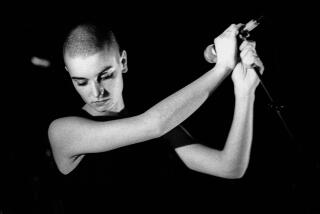Midge Turk Richardson dies at 82; ex-nun and Seventeen editor
- Share via
Midge Turk Richardson, a former nun and parochial school principal in Los Angeles who cast off her habit for the world of New York publishing, where she reigned for nearly two decades as editor of Seventeen magazine, has died. She was 82.
Richardson, who was found in her New York City home Dec. 17, appeared to have died in her sleep from natural causes, according to her stepson, Kevin Richardson.
A Los Angeles native, Richardson spent 18 years as a nun in the order of the Sisters of the Immaculate Heart of Mary, including seven years as superintendent of Our Lady Queen of Angels High School.
She left the order in 1966, a few years before it disbanded in a dispute with Cardinal James Francis McIntyre of the Los Angeles Archdiocese over reforms addressed by the Second Vatican Council.
Richardson described the personal upheaval of those years in a 1971 memoir, “The Buried Life,” which one reviewer praised as “more than the usual litany of disenchantment with religious life.”
In her new life, she joined the New York social swirl, married a former tennis star and in 1975 became editor of Seventeen, the iconic magazine for teenage girls founded in 1944. As the publication’s longest-serving editor, Richardson played a central role in expanding its coverage beyond beauty and fashion to college, careers and issues such as feminism and human rights.
She also featured frank discussions of such topics as sex, abortion, gynecological health, eating disorders and depression. She wrote a regular column called “Sex and Your Body.”
“She was such a legend,” said Ann Shoket, the magazine’s current editor. “The magazine’s role under Midge was to explain the world to young women, help them see beyond what was happening in their lives.”
Richardson often said she saw her work with the magazine as a natural extension of her previous role as an educator.
“Life is moving so much faster for this generation,” she told the Chicago Tribune in 1989. “They’re talking about jobs and college when they’re 15.... They are making a lot of very serious choices [about sex] at a very early age. We have to educate them much sooner to deal with this.”
Running the country’s top magazine for adolescent girls was not in her sights when she was growing up in a Catholic family in Los Angeles in the 1930s and ‘40s. Born Agnes Turk on March 26, 1930, the daughter of a school administrator and his music teacher wife did some acting as a child, performing as an extra in more than 100 Hollywood movies, including some with Shirley Temple.
Her interests shifted as she grew older. “In my day, if there had been VISTA or the Peace Corps,” she told The Times in 1978, “I might have considered that. I was very idealistic and my family was traditional.”
Instead, she chose to become a teaching nun. She joined the Sisters of the Immaculate Heart of Mary in 1948 when she was 18. In 1952, she graduated from Immaculate Heart College with a bachelor’s degree in English, followed by a master’s in the same subject in 1957.
She taught English, French and drama in local parochial schools, including Immaculate Heart High School. Later she was principal of Our Lady Queen of Angels High School, which had a low-income, largely Latino enrollment, and was promoted to mother superior.
In 1966, she faced what she called “the most difficult decision of my life.” The Vatican II reforms of the early 1960s were an attempt to modernize the church during an era of tremendous social tumult, but they were strongly opposed by McIntyre, who refused to soften rules governing such matters as what time nuns went to bed and whether they had to wear habits when they taught in Catholic schools.
Richardson, who was Sister Agnes Marie in her religious life, was particularly upset about what she saw as the church’s inadequate attention to the concerns of the poor community she served, especially the need for birth control. After experiencing two episodes of temporary blindness that her doctors said was caused by stress, she decided to leave religious life.
“The amount of compromise we were asked to make — I just couldn’t do it,” she told The Times in 1978. “I had to realize people I believed in didn’t want to give as much as I did.”
In 1970, four years after she left the order, its mother superior, Anita Caspary, and the 300 nuns who followed her broke with the church and formed the Immaculate Heart Community, a lay Christian group.
Richardson moved to New York, where she was hired as a teacher and assistant to the dean at New York University’s School of the Arts. She attracted the attention of Glamour magazine after participating in a “design-in” at Central Park and in 1967 became its college editor.
After leaving Glamour in 1974, she briefly edited Scholastic’s teen magazine Coed before she was lured to Seventeen as executive editor.
She was 44 when she married Hamilton Richardson, a Rhodes scholar and former Davis Cup tennis star who had gone into the oil and gas business. He died in 2006. She is survived by three stepchildren; two sisters; and five step-grandchildren.
More to Read
Start your day right
Sign up for Essential California for the L.A. Times biggest news, features and recommendations in your inbox six days a week.
You may occasionally receive promotional content from the Los Angeles Times.







